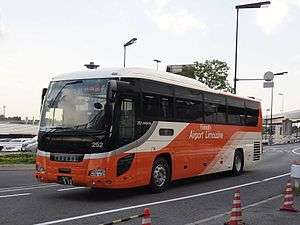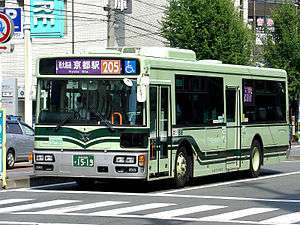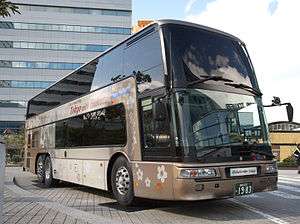Bus travel in Japan
Understand
Whether it's connecting small towns, big cities or airports, buses are an important and relatively inexpensive mode of transportation in Japan.
The most popular buses are those that streak along Japan's expressways by night. Several decades ago, the preferred mode of overnight transportation was on the country's network of sleeper trains. Over time, buses began to take center stage while overnight train service declined in both popularity and reliability. Today, fierce competition between bus operators results in better prices, and for those willing to pay a little extra, better amenities.
In other parts of the country - such as Kyoto where rail transit is sparse, or Hakone where winding roads must be navigated to reach popular hotels and hot springs - the bus becomes indispensable.
Highway buses
Long-distance highway buses (高速バス kōsoku basu; ハイウェイバス haiwei basu) serve many of the inter-city routes covered by trains at significantly lower prices, but take much longer than the Shinkansen. There is a multitude of operators, including Star Express and Willer Express, Kansai Bus, as well as companies of the JR group.
Many of these are overnight runs (夜行バス yakō basu), which allows you to save on a night's accommodation. It may be worth it to pay a premium to get a better seat; remember that it is less fun to sightsee after a sleepless night. Look out for 2列シート niretsu shitto or 3列シート sanretsu shiito, meaning there are only two or three seats per row instead of four. Intercity buses usually have significantly less legroom than intercity trains, so passengers over about 175 cm may be uncomfortable.
More buses are now offering more luxurious Premium Seating. These seats are bigger, offer more legroom, and are exclusive, with only a few seats allocated to an entire bus. Examples include the first floor seating on JR Bus' Premium Dream service, Cocoon seats on Willer Express services, and Kanto Bus' Dream Sleeper Gussuri which has eleven seats with sliding privacy doors.
Some overnight buses can only be used by women, while some companies will endeavor to make sure that solo women travelers are not seated next to solo men travelers.
For most long-distance journeys, buses will make a few rest stops along the way at one of Japan's Service Areas (abbreviated SA for short). Service Areas offer vending machines, convenience stores, shops, and of course, toilets. Note that the rest stops are short, so be sure to be on time for the departure of your bus.
Tickets
Bus tickets can be purchased at the point of departure, at a convenience store kiosk or on the internet, but some command of Japanese may be necessary. Thankfully, a few companies do offer online reservations in a language other than Japanese. Willer Express, for example, offers online bus reservations in English, Chinese and Korean. Keio Bus offers English reservations for their buses between Tokyo and the Mount Fuji area. More recently, a few members of the JR Group (JR Bus Kanto, JR Tokai Bus) have begun online reservations in English for their core routes.
The amount of competition between bus operators in recent years - in particular buses between Tokyo and Kansai - has led to the adoption of dynamic pricing on many routes. This means that the price of a ticket will vary based on several factors, including:
- When the ticket is purchased: Discounts are sometimes offered for tickets bought several days in advance.
- The date of travel: A regular weekday trip will be among the lowest priced. Weekend travel is typically priced slightly higher, and trips during peak periods (e.g. Golden Week, New Year's) will be the most expensive.
- The time of day: Day trips by bus are less expensive than overnight trips.
- The type of seating on the bus: High density buses designed to carry more passengers are cheaper. Buses with fewer seats per row - and fewer seats on the bus in total - are priced higher.
A few highway bus routes still operate on fixed fare structures, where the fare is the same regardless of the date of travel.
Bus Passes
Two national bus passes are available for foreign visitors: the Japan Bus Pass and the JBL Pass.
Japan Bus Pass
Bus operator Willer Express offers the Japan Bus Pass for travel on their network of highway buses. It is available to anyone with a foreign passport, including tourists and residents.
There are two versions: A weekday pass, or Monday-Thursday pass, costs ¥10000 for 3 days, ¥12500 for 5 days or ¥15000 for 7 days. An All-Day pass costs ¥12500 for 3 days or ¥15000 for 5 days. Travel days are non-consecutive, but passes must be used up within two months. You are limited to a maximum of three bus trips per day. Passes are not transferable and photo identification is required when boarding the buses.
If you have a lot of time on your hands, want to visit several major cities in a single trip, and do not mind the time spent on buses (including sleeping), then the Bus Pass is worth considering. The more trips you take, the more cost-effective the pass will be. You can potentially ride Willer Express buses for as little as ¥1000 per trip.
There are a couple of small drawbacks to using the Bus Pass:
- Bus Passes are blacked out during Japan's major holidays, such as New Year's, Golden Week and Obon. Otherwise, a Monday-Thursday pass can only be used for Monday-Thursday bus departures, while an All-Day pass can be used on any day.
- You are restricted to using buses that seat four to a row.
JBL Pass
The Japan Bus Lines' JBL Pass is similar to the Japan Bus Pass, with a few notable differences:
- It covers a greater number of routes from bus companies affiliated with the Japan Bus Lines network.
- You can use buses that seat either three or four to a row.
- You can use the pass to travel on any day, except peak holidays which are blacked out.
The pass for 7 consecutive days costs ¥20000, and the pass for 14 consecutive days costs ¥28000.
Airport buses

Buses are also a cheap method of traveling to and from Japan's airports. Major cities such as Tokyo and Osaka have an entire network of buses radiating out to major hotels, bus terminals and train stations, but even in smaller domestic airports you're likely to find buses operating to the city center - some will operate based on the arrival or departure of scheduled flights.
Some of the airport buses in major cities such as Tokyo and Osaka are known as Limousine Buses (リムジンバス rimujin basu). Some limousine buses run to dedicated terminals in the city which are strategically located to aim for consistent, on-time trips. Two such terminals around Tokyo - the Tokyo City Air Terminal (T-CAT) and Yokohama City Air Terminal (Y-CAT) - are right next to major highways.
Some companies offer discounts off of the normal bus fare to foreign tourists, or bundle bus tickets with other extras like a daily subway pass. Also look out for low-cost operators that simply offer cheap bus rates outright, such as the ¥1000 Access Narita bus that operates between Tokyo and Narita Airport.
Airport buses have varying rules on the amount of luggage allowed in the hold per passenger (number of pieces and maximum weight), so you may wish to verify this information in advance.
Local buses

You won't need to use local buses (路線バス rosen basu) much in the major cities, but they're common in smaller towns and the idiosyncratic payment system is worth a mention. On most buses, you're expected to board from the back and grab a little numbered slip as you enter, often just a white piece of paper automatically stamped by the dispenser as you pull it. In the front of the bus, above the driver, is an electronic board displaying numbers and prices below, which march inexorably higher as the bus moves on. When it's time to get off, you press the stop button, match your numbered slip to the electronic board's current price, deposit the slip and corresponding payment in the fare machine next to the driver, then exit through the front door. Note that you must pay the exact fare: to facilitate this, the machine nearly always has bill exchanger built in, which will eat ¥1,000 bills and spew out ¥1,000 worth of coins in exchange. If you're short on change, it's best to exchange before it's time to get off.
Increasingly, buses accept smartcards such as PASMO and Suica - you will need to tap your card against a scanner by the entrance (usually above the ticket dispenser) and then again using the scanner next to the fare machine by the driver when you exit. If you fail to 'tap on' when boarding, you will be charged the maximum fare when alighting.
The electronic board almost always includes a display and recorded voice announcements of the next stop — usually only in Japanese, although some cities (like Kyoto) make a welcome exception. However, if asked most drivers will be glad to tell you when you've reached your destination.
